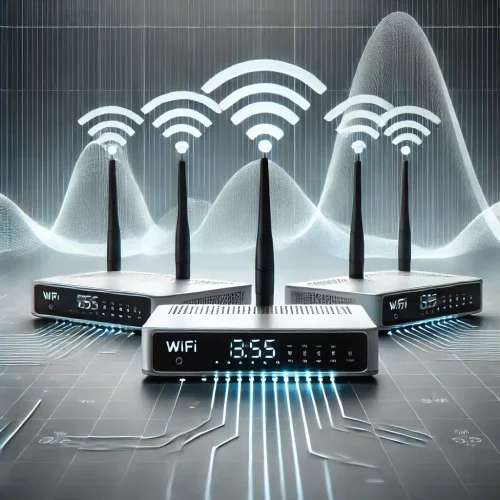The development of WLAN standards: What you need to know

The current standard, 802.11ax or Wi-Fi 6, offers improved efficiency, higher data rates and better performance in densely populated areas. Wi-Fi standards have continuously evolved to meet the growing demands for speed and capacity. For the future, work is already underway on Wi-Fi 7, which promises even higher speeds and lower latency.
Overview of the WLAN standards: From 802.11b to Wi-Fi 6
This was followed by 802.11g in 2003, which also operated in the 2.4 GHz band, but enabled a higher data rate of up to 54 Mbps. 802.11n, also known as Wi-Fi 4, brought improvements in 2009 with MIMO technology and dual frequency bands (2.4 GHz and 5 GHz), enabling data rates of up to 600 Mbps.
802.11ac, or Wi-Fi 5, introduced higher bandwidths and better performance in the 5 GHz band in 2013, with speeds of up to 3.5 Gbps. The latest standard, Wi-Fi 6 (802.11ax), was introduced in 2019 and offers improved efficiency, higher speeds and better performance in dense networks, with data rates of up to 9.6 Gbit/s.

WLAN standards in comparison: speed, range and security
WiFi standards have evolved significantly over the years, now offering better speeds, greater ranges and improved security features.
Modern Wi-Fi technology allows users to enjoy a reliable and fast internet connection.
With the advancement of Wi-Fi standards, wireless networks can now better handle the demands of high data transfer rates.
These advances make surfing the internet, streaming videos and downloading files more efficient and faster.
The new wireless technologies also offer greater stability and security, which improves the protection of sensitive data on the Internet.
Overall, these developments have helped to make the use of WiFi better and more convenient.
The older 802.11b standard offers speeds of up to 11 Mbit/s and a range of around 35 meters indoors.
In comparison, 802.11g delivers up to 54 Mbit/s with a similar range.
With 802.11n, speeds increased to up to 600 Mbit/s and the range improved to up to 70 meters.
The latest standard, 802.11ac, offers speeds of up to 1.3 Gbit/s and an improved range.
There has also been progress in terms of security.
While WEP (Wired Equivalent Privacy) was used in the 802.11b standard, newer standards WPA (Wi-Fi Protected Access) and WPA2 offer significantly improved security protocols.
The choice of the right standard depends on the specific requirements in terms of speed, range and security.
Zero tolerance for security vulnerabilities should be the top priority.
The future of WLAN standards: What will Wi-Fi 7 bring?
Wi-Fi 7, also known as IEEE 802.11be, represents the next generation of WLAN technology.
It promises significant performance improvements and new functionalities.
Compared to its predecessors, Wi-Fi 7 offers higher speeds, lower latency and improved network reliability.
This is achieved through the introduction of technologies such as Multi-Link Operation (MLO), extended channel bandwidths and improved modulation techniques.
A major advantage of Wi-Fi 7 is the support of 320 MHz channels, which significantly increases the data transmission rate.
It also enables the use of 4096-QAM (Quadrature Amplitude Modulation), which offers greater efficiency in data transmission.
These improvements are particularly relevant for applications such as virtual reality, augmented reality and 4K streaming, which require high bandwidth and low latency.
Overall, Wi-Fi 7 will form the basis for increasing digitalization and networking in homes and businesses.
WLAN standards explained: Which technology suits your needs?
Choosing the right Wi-Fi standard is crucial for efficient network performance.
The most common standards are 802.11n, 802.11ac and 802.11ax.
- 802.11n (Wi-Fi 4) offers a maximum data rate of 600 Mbps and is ideal for basic Internet use and smaller households.
- 802.11ac (Wi-Fi 5) achieves speeds of up to 3.5 Gbit/s and is suitable for HD streaming and online gaming in medium-sized households.
- 802.11ax (Wi-Fi 6) offers the highest performance with speeds up to 9.6 Gbps, improved network density and lower latency.
It is the best choice for smart homes and large families with many connected devices.
Choosing the right standard depends on your specific requirements, such as Internet speed, number of devices and type of use.
Also consider the future-proofing of your investment.
Address
Wilhelm-Spaeth-Strasse 2
90461 Nuremberg
Social media
Hotline
Germany only
0800-1488750
International
+49 911-148875-20
WhatsApp
+49 (0)911 148875-0
The opening hours
Monday to Friday, 09:00 to 18:00













